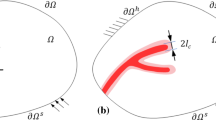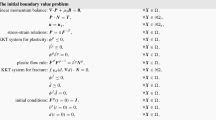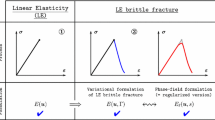Abstract
In the last few years, several authors have proposed different phase-field models aimed at describing ductile fracture phenomena. Most of these models fall within the class of variational approaches to fracture proposed by Francfort and Marigo [13]. For the case of brittle materials, the key concept due to Griffith consists in viewing crack growth as the result of a competition between bulk elastic energy and surface energy. For ductile materials, however, an additional contribution to the energy dissipation is present, related to plastic deformations. Of crucial importance, for the performance of the modeling approaches, is the way the coupling is realized between plasticity and phase field evolution. Our aim is a critical revision of the main constitutive choices underlying the available models and a comparative study of the resulting predictive capabilities.
Access this chapter
Tax calculation will be finalised at checkout
Purchases are for personal use only
Similar content being viewed by others
Notes
- 1.
In the gradient damage context, a different expression is often considered instead of (7), namely
$$\begin{aligned} \varDelta _{\mathrm{{d}}}({d},\nabla {{d}}) := \mathrm {w}({d}) + \frac{1}{2}\ell _{\mathrm{{d}}}^2\mathrm {w}_1| \nabla {{d}} |^2 \qquad {(5)} \end{aligned}$$The constitutive functions and constants are linked by the following relations
$$\begin{aligned} \ell _{\mathrm{{d}}} = \sqrt{2}\ell , \qquad \mathrm {w}(1) =: \mathrm {w}_1 = G_\mathrm{{c}}/(\ell c_{\omega }), \qquad \mathrm {w}({d})/\mathrm {w}_1 = \omega ({d}) \qquad {(6)} \end{aligned}$$.
References
R. Alessi, J.J. Marigo, S. Vidoli, Gradient damage models coupled with plasticity and nucleation of cohesive cracks. Arch. Ration. Mech. Anal. 214(2), 575–615 (2014)
R. Alessi, J.J. Marigo, S. Vidoli, Gradient damage models coupled with plasticity: variational formulation and main properties. Mech. Mater. 80(Part B), 351–367 (2015)
R. Alessi, J.J. Marigo, C. Maurini, S. Vidoli, Coupling damage and plasticity for a phase-field regularisation of brittle, cohesive and ductile fracture: one-dimensional examples. Int. J. Mech. Sci. In press (2017). doi:10.1016/j.ijmecsci.2017.05.047
M. Ambati, R. Kruse, L. De Lorenzis, A phase-field model for ductile fracture at finite strains and its experimental verification. Comput. Mech. 57, 149–167 (2016)
M. Ambati, T. Gerasimov, L. De Lorenzis, Phase-field modeling of ductile fracture. Comput. Mech. 55(5), 1017–1040 (2015)
L. Ambrosio, V.M. Tortorelli, Approximation of functional depending on jumps by elliptic functional via Gamma-convergence. Commun. Pure Appl. Math. 43(8), 999–1036 (1990)
H. Amor, J.J. Marigo, C. Maurini, Regularized formulation of the variational brittle fracture with unilateral contact: numerical experiments. J. Mech. Phys. Solids 57(8), 1209–1229 (2009)
M.J. Borden, C.V. Verhoosel, M.A. Scott, T.J.R. Hughes, C.M. Landis, A phase-field description of dynamic brittle fracture. Comput. Methods Appl. Mech. Eng. 217, 77–95 (2012)
M.J. Borden, T.J.R. Hughes, C.M. Landis, A. Anvari, I.J. Lee, A phase-field formulation for fracture in ductile materials: finite deformation balance law derivation, plastic degradation, and stress triaxiality effects. Comput. Methods Appl. Mech. Eng. 312, 130–166 (2016)
B. Bourdin, G.A. Francfort, J.J. Marigo, The variational approach to fracture. J. Elast. 91(1), 5–148 (2008)
G. Dal Maso, G. Orlando, R. Toader, Fracture models for elasto-plastic materials as limits of gradient damage models coupled with plasticity: the antiplane case. Calc. Var. Partial Differ. Equ. 55(3), 45 (2016)
F.P. Duda, A. Ciarbonetti, P.J. Sánchez, A.E. Huespe, A phase-field/gradient damage model for brittle fracture in elastic-plastic solids. Int. J. Plast. 65, 269–296 (2015)
G.A. Francfort, J.J. Marigo, Revisiting brittle fracture as an energy minimization problem. J. Mech. Phys. Solids 46(8), 1319–1342 (1998)
C. Kuhn, T. Noll, R. Müller, On phase field modeling of ductile fracture. GAMM-Mitteilungen 39(1), 35–54 (2016)
J.J. Marigo, C. Maurini, K. Pham, An overview of the modelling of fracture by gradient damage models. Meccanica 51(12), 3107–3128 (2016)
C. Miehe, F. Welschinger, M. Hofacker, Thermodynamically consistent phase-field models of fracture: variational principles and multi-field FE implementations. Int. J. Numer. Methods Eng. 83(10), 1273–1311 (2010)
C. Miehe, S. Teichtmeister, F. Aldakheel, Phase-field modelling of ductile fracture: a variational gradient-extended plasticity-damage theory and its micromorphic regularization. Philos. Trans. Ser. A, Math. Phys. Eng. Sci. 374(2066) (2016)
A. Mielke, T. Roubíček, Rate-Independent Systems: Theory and Application. (Springer, 2015)
K. Pham, J.J. Marigo, C. Maurini, The issues of the uniqueness and the stability of the homogeneous response in uniaxial tests with gradient damage models. J. Mech. Phys. Solids 59(6), 1163–1190 (2011)
J. Ulloa, P. Rodríguez, E. Samaniego, On the modeling of dissipative mechanisms in a ductile softening bar. J. Mech. Mater. Struct. 11(4), 463–490 (2016)
Acknowledgements
The authors would like to acknowledge the support of the DAAD through the project “Variational approach to fatigue phenomena with phase-field models”.
Author information
Authors and Affiliations
Corresponding author
Editor information
Editors and Affiliations
Rights and permissions
Copyright information
© 2018 Springer International Publishing AG
About this chapter
Cite this chapter
Alessi, R., Ambati, M., Gerasimov, T., Vidoli, S., De Lorenzis, L. (2018). Comparison of Phase-Field Models of Fracture Coupled with Plasticity. In: Oñate, E., Peric, D., de Souza Neto, E., Chiumenti, M. (eds) Advances in Computational Plasticity. Computational Methods in Applied Sciences, vol 46. Springer, Cham. https://doi.org/10.1007/978-3-319-60885-3_1
Download citation
DOI: https://doi.org/10.1007/978-3-319-60885-3_1
Published:
Publisher Name: Springer, Cham
Print ISBN: 978-3-319-60884-6
Online ISBN: 978-3-319-60885-3
eBook Packages: EngineeringEngineering (R0)




